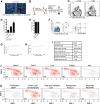Single-cell transcriptomes of murine bone marrow stromal cells reveal niche-associated heterogeneity
- PMID: 31149730
- PMCID: PMC6771914
- DOI: 10.1002/eji.201848053
Single-cell transcriptomes of murine bone marrow stromal cells reveal niche-associated heterogeneity
Abstract
Bone marrow (BM) stromal cells are important in the development and maintenance of cells of the immune system. Using single cell RNA sequencing, we here explore the functional and phenotypic heterogeneity of individual transcriptomes of 1167 murine BM mesenchymal stromal cells. These cells exhibit a tremendous heterogeneity of gene expression, which precludes the identification of defined subpopulations. However, according to the expression of 108 genes involved in the communication of stromal cells with hematopoietic cells, we have identified 14 non-overlapping subpopulations, with distinct cytokine or chemokine gene expression signatures. With respect to the maintenance of subsets of immune memory cells by stromal cells, we identified distinct subpopulations expressing Il7, Il15 and Tnfsf13b. Together, this study provides a comprehensive dissection of the BM stromal heterogeneity at the single cell transcriptome level and provides a basis to understand their lifestyle and their role as organizers of niches for the long-term maintenance of immune cells.
Keywords: bone marrow; cytokines; hematopoietic cells; single cell sequencing; stromal cells.
© 2019 The Authors. European Journal of Immunology published by WILEY-VCH Verlag GmbH & Co. KGaA, Weinheim.
Conflict of interest statement
The authors declare no financial or commercial conflict of interest.
Figures



References
-
- Tokoyoda, K. , Zehentmeier, S. , Hegazy, A. N. , Albrecht, I. , Grun, J. R. , Lohning, M. and Radbruch, A. , Professional memory CD4+ T lymphocytes preferentially reside and rest in the bone marrow. Immunity 2009. 30: 721–730. - PubMed
-
- Zehentmeier, S. , Roth, K. , Cseresnyes, Z. , Sercan, O. , Horn, K. , Niesner, R. A. , Chang, H. D. et al., Static and dynamic components synergize to form a stable survival niche for bone marrow plasma cells. Eur. J. Immunol. 2014. 44: 2306–2317. - PubMed
-
- Hanazawa, A. , Hayashizaki, K. , Shinoda, K. , Yagita, H. , Okumura, K. , Lohning, M. , Hara, T. et al., CD49b‐dependent establishment of T helper cell memory. Immunol. Cell Biol. 2013. 91: 524–531. - PubMed
Publication types
MeSH terms
Substances
LinkOut - more resources
Full Text Sources
Molecular Biology Databases

